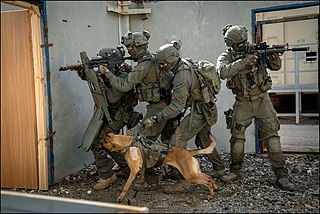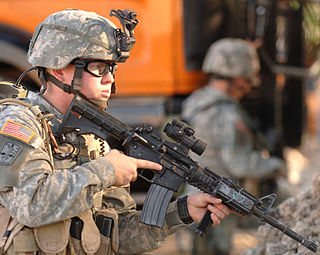Police Quest is a series of police simulation video games produced and published by Sierra On-Line between 1987 and 1998. The first five were adventure simulation games, the first three of which were designed by former police officer Jim Walls. The fourth to sixth titles were designed by former LAPD Chief Daryl F. Gates. Both SWAT and the real-time tactics game SWAT 2 still carried the Police Quest name and were numbered V and VI in the series, respectively, although subsequent titles in the series would drop the Police Quest title altogether and were rebranded as SWAT.

Urban warfare is combat conducted in urban areas such as towns and cities. Urban combat differs from combat in the open at both the operational and the tactical levels. Complicating factors in urban warfare include the presence of civilians and the complexity of the urban terrain. Urban combat operations may be conducted to capitalize on strategic or tactical advantages associated with the possession or the control of a particular urban area or to deny these advantages to the enemy.

Close-quarters combat (CQC) or close-quarters battle (CQB) is a close combat situation between multiple combatants involving ranged or melee combat. It can occur between military units, law enforcement and criminal elements, and in other similar situations.

The Yamam, also called in Hebrew היחידה המיוחדת ללוחמה בטרור and Israel's National Counter Terror Unit (I.N.C.T.U.) in English, is Israel's national counter-terrorism unit, one of four special units of the Israel Border Police. The Yamam is capable of both hostage-rescue operations and offensive take-over raids against terrorist targets in civilian areas. Besides military and counter-terrorism duties, it also performs SWAT duties and undercover police work.

SWAT 3: Close Quarters Battle is a tactical shooter video game developed by Sierra Northwest and published by Sierra Entertainment for Microsoft Windows-based PCs. It is the seventh installment of the Police Quest series and the first game in the series to be played from the first-person perspective. Unlike many other first-person shooter games, SWAT 3 places an emphasis on realistic police methods and tactics, including proper room clearance, use of less-lethal weaponry, ordering compliance and arresting enemies rather than shooting on sight, and differentiating between authorized and unauthorized use of lethal force.

The CompM2 is a battery-powered, non-magnifying red dot type of reflex sight for firearms manufactured by Aimpoint AB. It was first introduced in the U.S. Armed Forces in 2000, designated as the M68 Close Combat Optic. It is also known as the M68 Aimpoint and is designed to meet United States military standards. The sight is designed for use with the M16/M4 family of rifles, but can be mounted on any weapon fitted with an upper Picatinny rail. It is also NVG-compatible—the aiming dot is still visible through night vision scopes and goggles. The Army's M68 designation was also applied to a later version of the sight, the Aimpoint CompM4.
Close Quarters Combat System is a modern martial art developed by William E. Fairbairn and Eric A. Sykes prior to World War II. It is a hand-to-hand combat system based on practical experience mixed with Jujutsu and boxing that was developed to train the Shanghai Municipal Police, and was later taught in expanded form to Office of Strategic Services and Special Operations Executive members during World War II.

Hand-to-hand combat is a physical confrontation between two or more persons at short range that does not involve the use of weapons. The phrase "hand-to-hand" sometimes include use of melee weapons such as knives, swords, clubs, spears, axes, or improvised weapons such as entrenching tools. While the term "hand-to-hand combat" originally referred principally to engagements by combatants on the battlefield, it can also refer to any personal physical engagement by two or more people, including law enforcement officers, civilians, and criminals.

The Close Quarter Battle Receiver (CQBR) is a replacement upper receiver for the M4A1 Carbine, developed by the US Navy.
Swat or SWAT may refer to:

Combat Missions was a one-hour-long reality TV show produced by Mark Burnett and hosted by former Survivor castaway Rudy Boesch that aired from January to April in 2002 on the USA Network. It pits four teams of highly experienced military and police operatives against each other in physical challenges and "mission" scenarios. Each team has a call sign and corresponding color. The four teams are Alpha (Red), Bravo (Blue), Charlie (Yellow) and Delta (Green). The team members were past and present members of SWAT, the United States Army Special Forces, the Navy SEALs, Marine Recon, the CIA Special Operations Group, Delta Force, and the U.S. Army Rangers. The mission scenarios has each team face off against the opposing "Shadow force" using MILES gear in real-life combat situations. The show was not picked up for a second season.
Western Arms is an airsoft gun manufacturer. They primarily manufacture 1911 and 2011 variants, though they do make several Beretta 92 types and have made other types of pistols. Recently, they have added three types of GBB M4 carbine rifles to their lineup of gas powered replicas. Currently, they only produce gas powered blowback replicas, though they have made gas-electric hybrids in the past.

The AA-12, originally designed and known as the Atchisson Assault Shotgun, is an automatic combat shotgun developed in 1972 by Maxwell Atchisson. The most prominent feature is reduced recoil. The current 2005 version has been developed over 18 years since the patent was sold to Military Police Systems, Inc. The original design was the basis of several later weapons, including the USAS-12 combat shotgun. The shotgun fires in fully automatic mode only. However, the relatively low cyclic rate of fire of around 300 rounds per minute enables the shooter to fire semi-automatically de facto with brief trigger pulls. It is fed from either an 8-shell box magazine or a 20-shell drum magazine.

Matt Larsen is a former United States Marine, United States Army Ranger and Black Belt Magazine Hall of Fame combatives instructor. He is known as "The Father of Modern Combatives", credited with the creation of the United States Army's modern combatives doctrine and the establishment of the U.S. Army Combatives School. Larsen is also a Evolutionary Psychologist specializing in Combat Psychology, and is currently the Director of Combatives at the United States Military Academy at West Point.

Close combat is a combat situation between two or more opponents at short range. Since the rise of ranged weapons and firearms, the term has been used to specifically refer to melee combat.

Thunder Squad is a special services unit of the National Police Agency in Taiwan, a highly trained SWAT unit established in 1985 to conduct high-risk arrests and other dangerous law enforcement duties. This 200 man group is organized into small four-man elements, three of which make up an operating group.

The Marine Corps Security Force Regiment is a dedicated security and anti-terrorism unit of the United States Marine Corps. It provides security forces to guard high-value naval installations, most notably those containing nuclear vessels and weapons. It also provides Fleet Anti-terrorism Security Teams (FAST) and Recapture Tactics Teams (RTT). Marines who complete Security Forces training are assigned a secondary Military Occupational Specialty (MOS) of 8152, while instructors can earn 8153.
The Special Operations Training Group, or SOTG, is a training section of the United States Marine Corps providing Marine Expeditionary Force (MEF) commanders with training facilities and a liaison for Marine Expeditionary Units (MEU). The SOTG provides special operations training for various branches and also participates in the MEUs' Special Operations Capable Certification by acting as the "Training and Evaluation Board" for the exercises and events during the MEU annual training cycles.

Seema Rao is popularly known as “Wonder Woman of India” in the Indian media. She is India's first female special forces trainer, having trained Special Forces of India for over two decades without compensation. She is an expert in close quarter battle (CQB) — the art of fighting in tight proximity — and is involved in training various Indian forces. She works in partnership with Major Deepak Rao, her husband.
"CQB" is the fourth episode of the first season of the American science fiction television series The Expanse. It initially aired on Syfy in the United States on December 29, 2015, a week after the previous episode, and was watched by 633,000 viewers in its initial viewing. The episode was written by Naren Shankar and directed by Jeff Woolnough.












